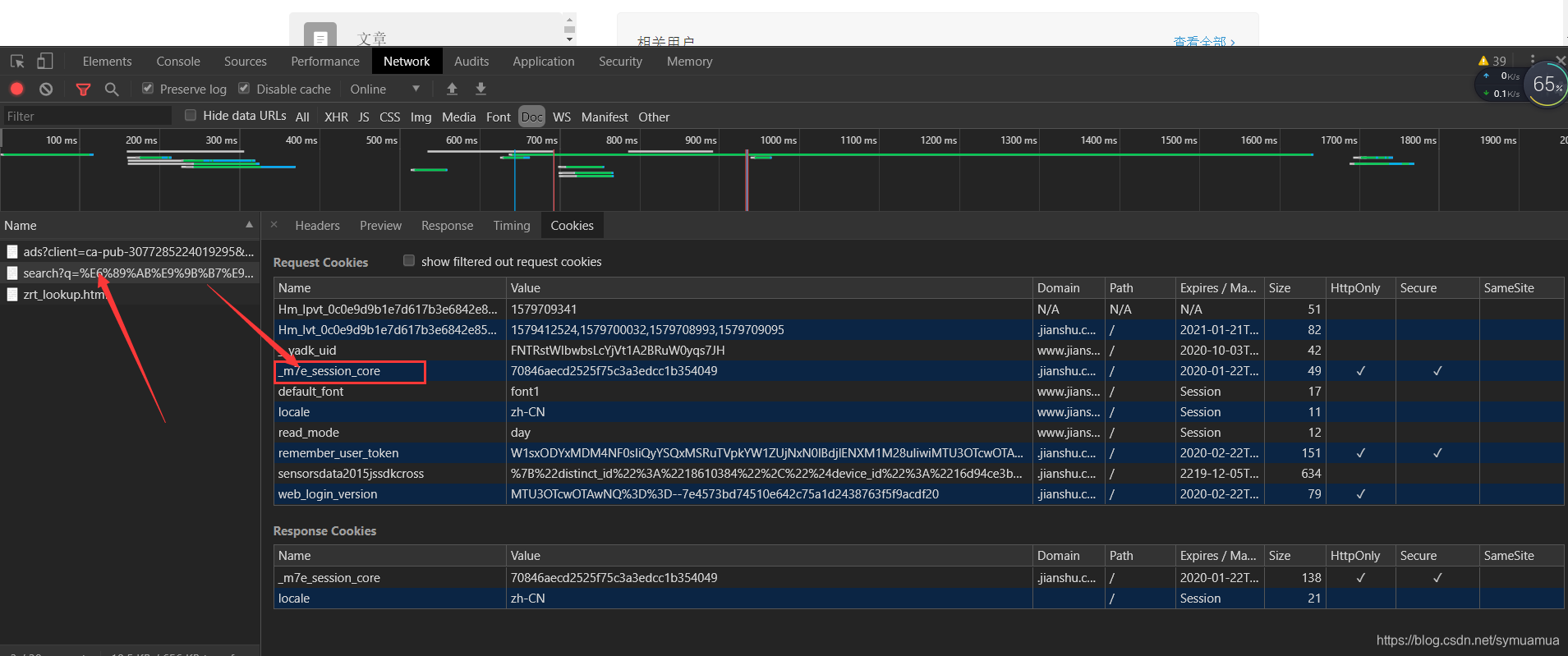有关于简书页面爬取破解的两个爬虫编写时间20200104

目录
有关于简书页面爬取破解的两个爬虫(编写时间20200104)
由于课程设计需要编写了一系列爬虫,期中包括:
- 博客园页面+博客园搜索
- 百度搜索+百度文库
- 简书搜索+简书页面
- 爱学术搜索
具体目的就详细说明,反正就搜集一下资料和URL
下为简书的两个爬虫(编写时间20200104)
- 首先是简书页面爬虫,这个是基础爬虫,并没有什么反爬措施,只要频率别太高一般是可以用的
import requests
import time
from lxml import etree
import random
import os
import json
headers = {
"User-Agent": "Mozilla/5.0 (Windows NT 10.0; WOW64) AppleWebKit/537.36 (KHTML, like Gecko) Chrome/73.0.3683.86 Safari/537.36",
}
def getContent(url):
try:
re = requests.get(url,headers = headers)
re.encoding = re.apparent_encoding
# print(re.text)
html = etree.HTML(re.text)
title = html.xpath("//*[@id='__next']/div[1]/div/div/section[1]/h1/text()")
content = []
for each in html.xpath("//*[@id='__next']/div[1]/div/div/section[1]/article/*"):
con_temp = each.xpath("string(.)")
if con_temp:
content.append(str(con_temp))
con_temp = each.xpath(".//@data-original-src")
if con_temp:
for ImgIndex in range(len(con_temp)):
if ImgIndex>0 and con_temp[ImgIndex] is not con_temp[ImgIndex-1]:
content.append("".format(con_temp[ImgIndex]))
elif ImgIndex==0:
content.append("".format(con_temp[ImgIndex]))
# print(ImgIndex,con_temp[ImgIndex])
return title,content
except:
return "",""
def save(title,content):
with open("{}.md".format(title[0]),'w',encoding='utf-8') as f:
f.write(str(title[0])+'\n\n')
for each in content:
f.write(each+'\n')
if __name__ == '__main__':
url = "https://www.jianshu.com/p/280c6a6f2594"
url = "https://www.jianshu.com/p/d75211cec9df"
title,content = getContent(url)
if title is not "":
save(title,content)
pass
else:
print("访问出错,请确认下url试试")接下来是比较有意思的简书搜索爬虫——简书搜索爬虫

就是这个搜索框(由于这个爬虫是20年1月4号编写,可能存在一定的局限性)
没错、这个搜索功能的返回值动态的、似乎还有个密码
在请求头中有几样必不可少的东西,分别是:x-csrf-token、_m7e_session_core还有user-agent
user-agent好说,是不变的,但是前两个是动态生成的,是会变的,如何破解它的生成机制就是关键
仔细分析搜索简书分析流程发现简书的搜索分为两个步骤:
- 1.搜索
url = "https://www.jianshu.com/search?q={}&page=1&type=note".format(word) - 2.搜索
url = "https://www.jianshu.com/search/do?q={}&type=note&page={}&order_by=default".format( word, page)
- 1.搜索
第一步search下的这个URL,会返回一个页面,具体长啥样忘了,这个页面里就直接存在期中一个值
head["x-csrf-token"] = str(html.xpath("//*[@name='csrf-token']/@content")[0]),就是这个x-csrf-token,我们可以通过xpath获得,另外一个值在cookie中strCookie = "_m7e_session_core={};".format( re.cookies.get("_m7e_session_core"))通过类似与字典取值的方法将这个cookie取出来,然后用这两个值二次构造我们的header请求头第二步do下的这个URL是请求真正的数据的,也是此行的主要目标,用上二次构造好的header重新访问,即可拿到真正的数据,是Json的,接下来就是机械化地分析~数据处理等
PS 更新:文末会指出两个关键值的所在位置
import requests
import time
from lxml import etree
import random
import os
import json
import utils.Utils as sq
headers = {
"User-Agent": "Mozilla/5.0 (Windows NT 10.0; WOW64) AppleWebKit/537.36 (KHTML, like Gecko) Chrome/73.0.3683.86 Safari/537.36"
}
proxy_list = [
'117.90.131.247:8118',
'171.11.32.77:9999',
'223.199.31.112:9999',
'27.191.234.69:9999',
'223.199.31.5:9999',
'60.167.135.179:9999'
]
# 获取必要的两个访问头x-csrf-token和_m7e_session_core
def getCookie(word, head, proxy):
# 先通过必要的一次访问获取x-csrf-token值和cookie中_m7e_session_core的值,二次构造header
url = "https://www.jianshu.com/search?q={}&page=1&type=note".format(word)
re = requests.get(url=url, headers=head, timeout=30, proxies=proxy)
html = etree.HTML(re.text)
head["x-csrf-token"] = str(html.xpath("//*[@name='csrf-token']/@content")[0])
strCookie = "_m7e_session_core={};".format(
re.cookies.get("_m7e_session_core"))
head["cookie"] = strCookie
# print(head)
return head
def getContent(word, head, proxy, page, content, total_pages):
print("当前第{}页".format(page))
try:
# 用post请求访问真正数据
url = "https://www.jianshu.com/search/do?q={}&type=note&page={}&order_by=default".format(
word, page)
re = requests.post(url=url, headers=head, timeout=30, proxies=proxy)
# Json分析
js = json.loads(re.text)
# 从JSON中获取总页数
try:
if total_pages == 0:
total_pages = js["total_pages"]
data = js["entries"]
except:
print("total_pages or error")
if data:
for each in data:
temp_title = each["title"].replace("\"", "").replace("\n", "").replace(")", " ").replace("(",
" ").replace(
"\\", "")
temp_content = each["content"].replace("\"", "").replace("\n", "").replace(")", " ").replace("(",
" ").replace(
"\\", "")
temp_url = "https://www.jianshu.com/p/{}".format(each["slug"])
# print("{}\n{}\n{}\n\n".format(temp_title, temp_content, temp_url))
content.append([temp_url, temp_title, temp_content])
# 递归访问下一页
if total_pages != 0 and total_pages > page and page < 15:
time.sleep(1)
return getContent(word=word, head=head, proxy=proxy, page=page + 1, content=content,
total_pages=total_pages)
except NameError as e:
print(e, "访问出错")
return content
def do(word):
# 随机获取代理ip
proxy = {"http": random.choice(proxy_list)}
# print(proxy)
head = getCookie(word=word, head=headers.copy(), proxy=proxy)
content = getContent(word=word, head=head, proxy=proxy, page=1, content=[], total_pages=0)
print(len(content))
# for each in content:
# print("title={}\ncontent={}\nurl={}\n\n".format(each[0],each[1],each[2]))
sq.insert_into_inital_data(content, "简书")
if __name__ == '__main__':
word = "电路SAT"
do(word)总结
- 破解访问机制还是蛮有意思的,拿着自己的爬虫出来溜一圈才发现之前学的不过是皮毛罢了,简书这个还算比较简单的,CSDN这个我到现在还没完全破解,等我有时间了好好研究这个页面加密的问题是个什么情况。
- 刚刚回去翻了翻,似乎简书的搜索功能被关了?好像不太能用了
估计是在更新?还是就挂了?等它好了再尝试给它破解看看
更新:
- 搜索功能可以用了,发现似乎没啥变化
- 下面是:x-csrf-token的位置

- 下面是 : _m7e_session_core 的位置



